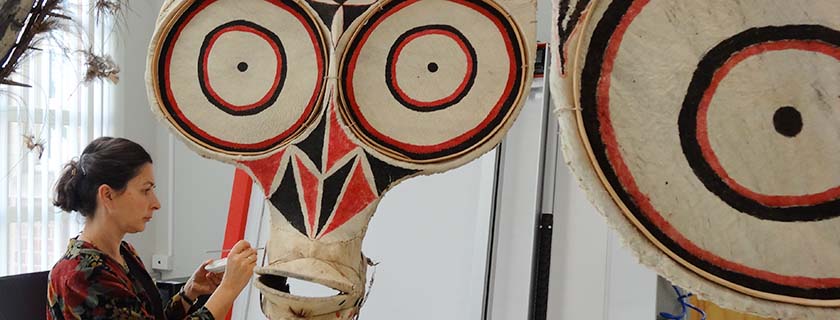 Conservation treatment, Kavat (mask) by New Guinean artist; South Australian Government Grant 1971, Art Gallery of South Australia, Adelaide
Conservation treatment, Kavat (mask) by New Guinean artist; South Australian Government Grant 1971, Art Gallery of South Australia, Adelaide
Australia’s rich migrant history is showcased in family collections originating from many different cultures. We conserve objects of world culture, diverse in art, material culture and age. In particular, we care for artefacts that reflect our place in the Asia Pacific region.
Australia has strong historic associations with Papua New Guinea and nearby Pacific nations through trades and services, WWI and WWII efforts, which is reflected in the objects we conserve from the South Australian Museum’s outstanding Pacific cultures collection.
Often our role is to provide advice for the care and supply of a suitable display mechanism, whether it is to hang a weaving on the wall or to support a figurative sculpture on a custom-designed armature and plinth. Items we treat include tapa cloths, basketry, earthenware, weaponry, masks, ornaments, jewellery, domestic and ritual items, lacquerware; carvings and furniture of bone, ivory, wood; ceramics; metalware; paintings and textiles.
If a damaged object is brought to us, particular sensitivity is required for treatment as matte, pigmented or porous surfaces can be easily stained by inappropriate adhesives. Even aligning and clamping break edges while an adhesive dries can be an art form, so as not to damage original surfaces.
We take care to ensure that significant evidence of past use is not removed from surfaces through cleaning or repair, particularly with archaeological or historic cultural material. For ancient artefacts, stabilisation is paramount and we aim to minimise intervention.
Protein materials like fur, feathers, rawhide and horn can be very vulnerable to insect attack. We can help by advising on the identification and response to pest infestations, and treat infestations by either deep freezing or using anoxic treatments.


